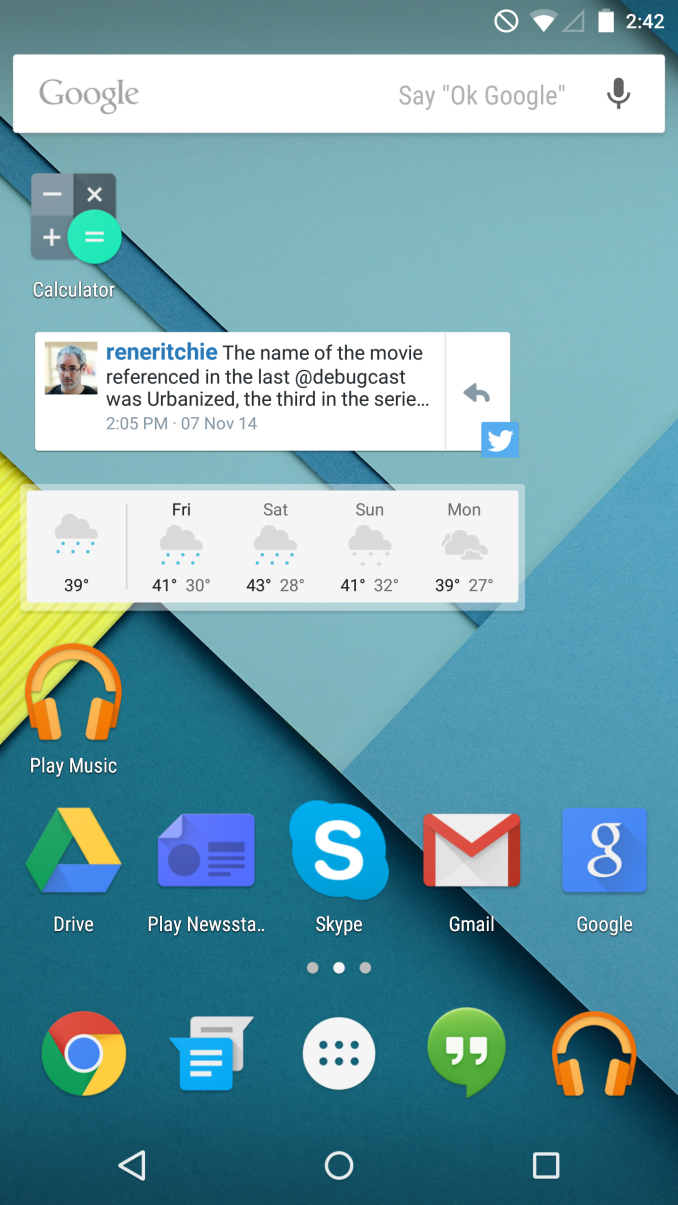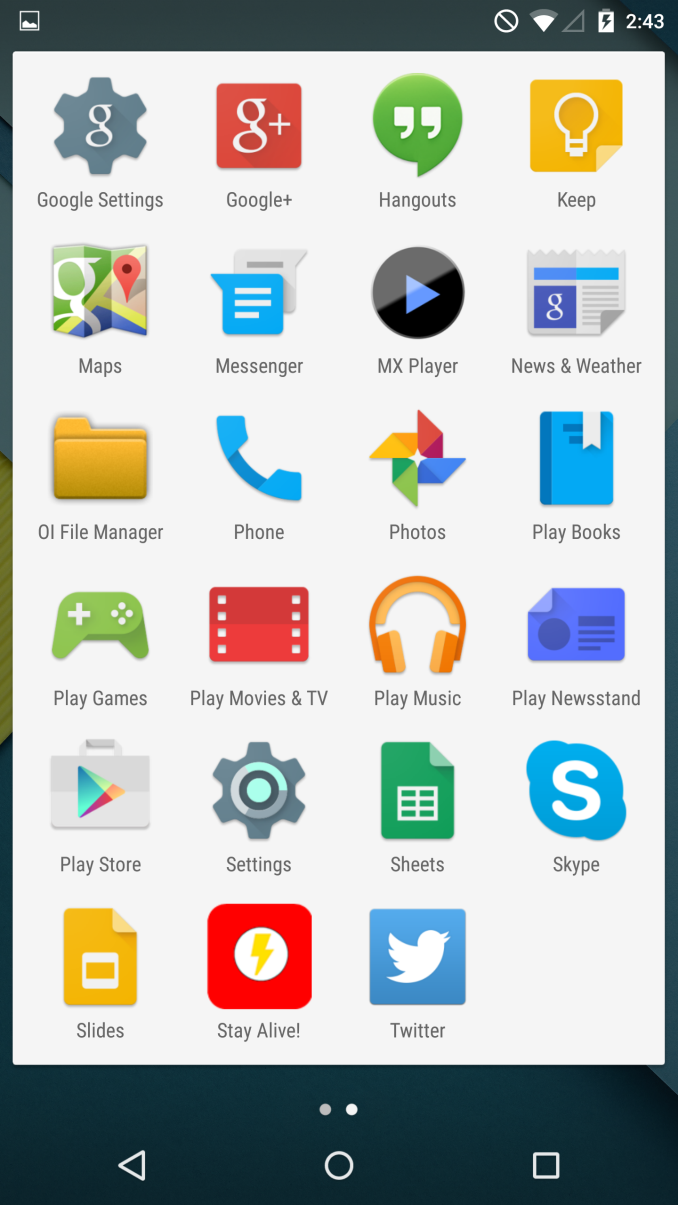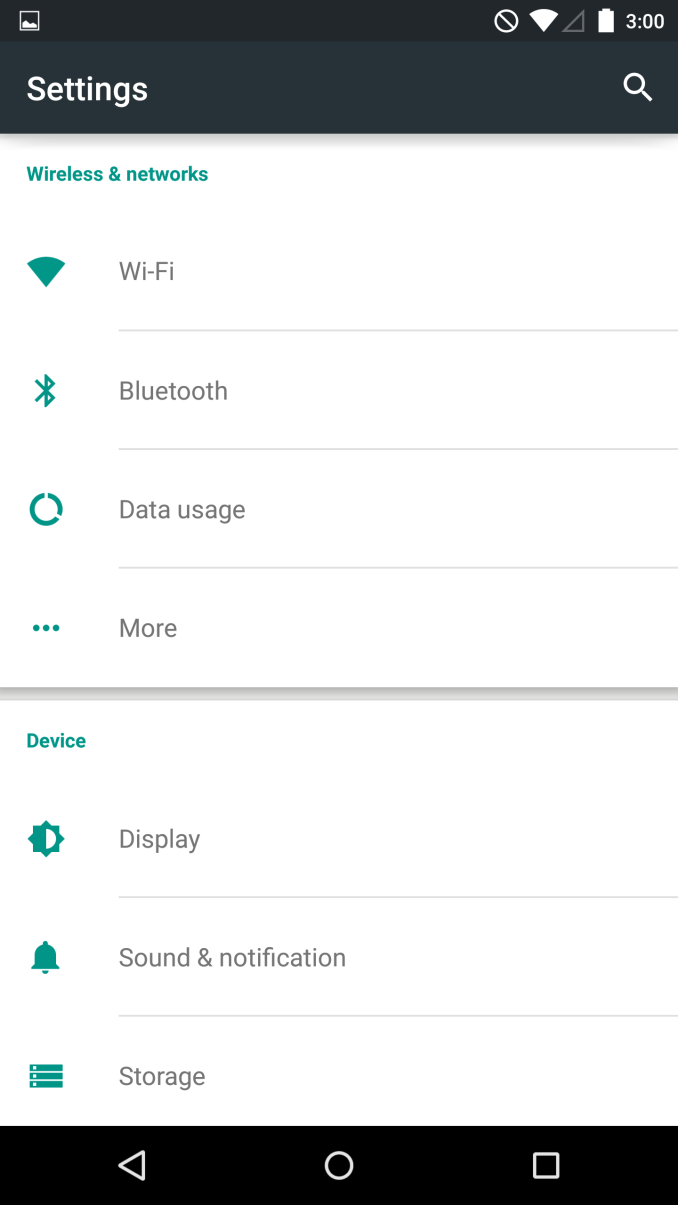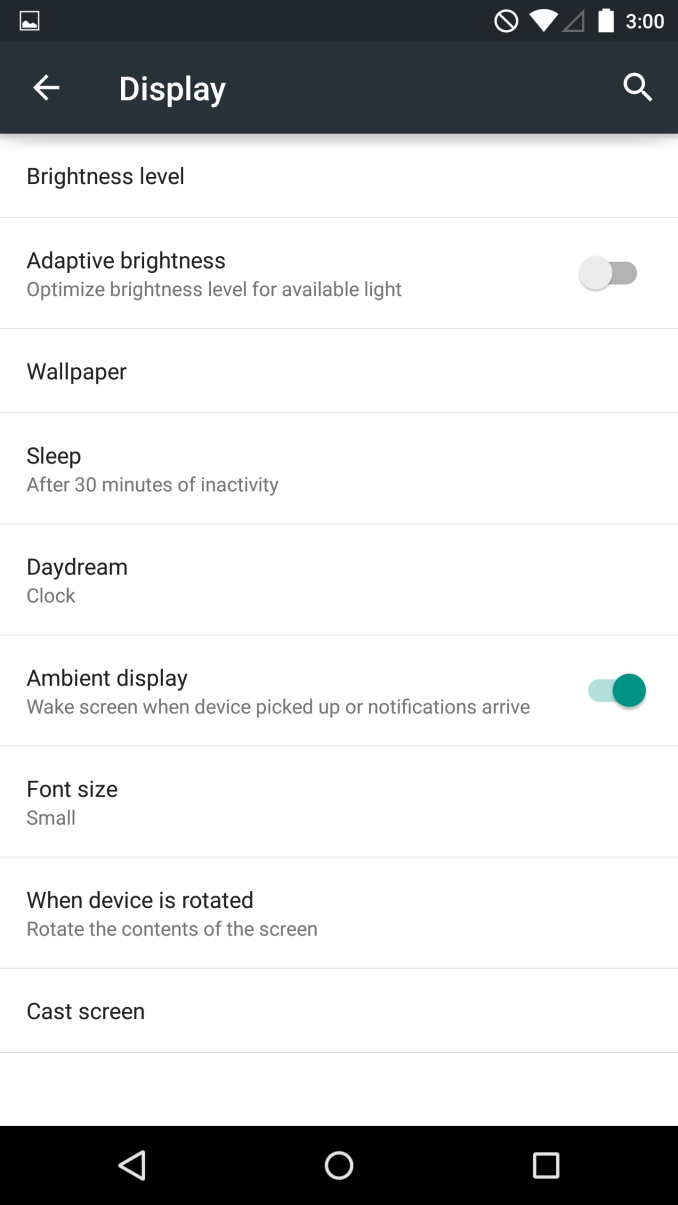The Nexus 6 Review
by Brandon Chester on November 12, 2014 1:00 PM ESTSoftware
The software on a smartphone is ultimately what defines whether or not it provides a good experience. Good hardware cannot save a device with poor software. The Nexus 6 comes with Google's latest iteration of Android, version 5.0 Lollipop. This is by far the biggest update the OS has seen in quite some time, with the last major visual overhaul occurring in 2011 with Android Ice Cream Sandwich. I plan to do a more in-depth look at Android Lollipop itself, but I do have some impressions of the operating system on the Nexus 6 specifically, as well as how it compares to Android Lollipop running on the Nexus 5. The most important question to answer about the software experience on the Nexus 6 is how well it takes advantage of the large display.
The most obvious starting point to look at is the launcher. While there are some visual changes from Android 4.4, the Google Now launcher is effectively the same in Android 5.0 as it was in 4.4 with regards to functionality. On the Nexus 6 it takes advantage of the larger display by adopting a 5x5 layout for applications and widgets on the home screens, and a 6x4 layout in the application drawer. The decision to only allow for four columns in the drawer seems to be more of an aesthetic one rather than a functional one, as it puts a greater amount of horizontal space between each icon. Google's decision to use a 5x5 layout on the home screen allows for a greater number of icons and widgets to be placed, but it also causes issues with many widgets that are non-resizeable and are fit to the typical 4 column width. This is something that will be fixed as time goes on and developers update their applications, and I support Google's decision to create some minor visual issues by allowing for more home screen space instead of simply making everything larger.
Unfortunately, some parts of Android Lollipop have a surprisingly low information density and this is made even more obvious on the large display. The main section of the Settings application is a particularly good example of this. As you can see above, even with the font size set to small there is a gratuitous amount of spacing between each label and the borders above and below it, which means that you are able to view far fewer sections on the screen at a single time. Fortunately this doesn't apply to the other parts of the application, but that also makes it seem inconsistently designed.
Above you can also see the toggle for Ambient display. This is a similar feature to Moto Display on the Moto X, where the display will turn on whenever a notification arrives or the phone is picked up. When this occurs, the lock screen is dimmer, with a black background and white used sparingly to conserve power. Thankfully, the extremely low display power consumption when this feature is in use means that it has no significant negative impact to battery life, and may actually improve it overall by eliminating the need to ramp up the CPU frequency and turn on the display fully whenever a notification arrives.
Providing a good video experience is something the Nexus 6 should excel at due to its massive display. Something that surprised me is that Google still has no actual video player application for Android, relying on playback through the photos application which has limited format support to say the least. At one time in the past the Play Movies & TV application had the ability to play videos stored locally, but now even that has been removed. To make matters worse, the version of MX Player on Google Play is incompatible with Android Lollipop and will not run. In my opinion, MX Player is the best video player on any mobile platform and not being able to test it would have been a great shame. Luckily, there is a version on the web which has been updated to run on Android Lollipop.
After finding a video player and sorting through any potential compatibility issues with the new OS, the video playback experience on the Nexus 6 is great in most cases. The contrast ratio of AMOLED displays makes some films look absolutely incredible, and the display calibration tends to not have a massive impact on live-action content. Animated content tends to use brighter and more highly saturated colors than what commonly appear in the real world, and so the over saturation does have a noticeable impact on how that looks on the Nexus 6 compared to a reference display. In terms of format support, it seems that video players don't yet have support for Qualcomm's HEVC decoder built into Snapdragon 805, and so any 1080p or 4K content encoded in High 10 Profile H.264 or HEVC brought the device to its knees. These are still fairly uncommon formats, and I doubt this will impact the experience for most users.
A good way to take advantage of a large display is by having special layouts in landscape mode. Apple did this with their iPhone 6 Plus by adding landscape support to Springboard, and by implementing dual-pane views in applications when displayed in landscape orientation. Samsung has also done this with some of their Touchwiz applications on the Galaxy Note 4. Unfortunately, Android Lollipop doesn't really have any special layouts made for the Nexus 6. While there are a couple of applications like Settings and Calculator that now have improved landscape views, these are perfectly usable on smaller devices like the Nexus 5 and are not unique to the Nexus 6. This makes it difficult to justify the sacrifice of one-handed usability to have such a large display, because the benefits are limited to just displaying a few more lines in Chrome or another row of icons. Google has obviously had to dedicate a lot of engineering resources to just getting Android Lollipop out the door, so it's possible that we'll see updates to enhance software on the Nexus 6, but as it is right now I'm wondering if Google possibly aimed a bit too high with the 5.96" screen size.
One last thing I would like to touch on is the performance of Android Lollipop on the Nexus 6. In this context, performance refers to the framerate of animations and any times where there are significant frame drops or freezes, which are commonly referred to as "jank". I am somewhat concerned because the Android Lollipop experience seems to have some areas with constantly low framerates or stuttering on the Nexus 6, despite all the promotion about the improved performance brought about by software optimization and the new ART runtime. However, what makes these issues interesting is that some of them do not exist on the Nexus 5 running the Android Lollipop preview, and I do not know the reason why. For the most part the experience is extremely smooth, smoother than Android has ever been. But certain applications like Calendar, Messages, and the notorious Google Play have animations that either frequently drop to 0fps which causes a visible stutter, or run not just below 60fps, but below 30fps, causing a sluggish animation. I am hopeful that these issues can be fixed with future software updates, but it's certainly surprising and concerning to see areas where the new device does not perform as well than the old one.















136 Comments
View All Comments
Spunjji - Friday, November 14, 2014 - link
A better battery and camera in this would persuade me to upgrade in a heartbeat. I only hope that if they eventually replace the 5 with an equivalently-sized phone (5 2015?) they keep the wonderful screen.niva - Friday, November 21, 2014 - link
Yes, I'm hoping for a Nexus 5 refresh with all the new fluff like the chip/ram/camera and battery. I think the Nexus 5 design and screen are perfect. My wife has a Nexus 5 and I'm still on my Gnex. Was hoping to get the 6 but with the size and price I'm going to wait some more. Roll on the Enyxos 810 phones and I might get whatever runs pure Android.PS. I cannot stand Touchwiz/Sense and whatever LG and Sony are doing on their "flagships." Thankfully Motorola has mostly stock interface.
techconc - Friday, November 14, 2014 - link
LOL! Good luck with that. The Nexus 5 is known to have weak radio signals and overall poor cell and WIFI reception. Not exactly the best choice and it's not really competitive with recent devices.owan - Wednesday, November 12, 2014 - link
Because Google isn't a charity?synaesthetic - Thursday, November 27, 2014 - link
Google would have been better off making another "almost-flagship" at the $350 price point. I've been using Nexus devices since the Nexus S, but now... no, it's just too damn big and too damn expensive.algarblandom - Wednesday, November 12, 2014 - link
Having a Nexus 5, I see very few reasons to upgrade to this, unless you stronly like phablets. But in almost every area (battery life, camera, cpu performance, software..) it is almost a draw.anactoraaron - Wednesday, November 12, 2014 - link
I'm curious, you've listed the nexus 5 as running lollipop in the first comparison chart... is it running the dev preview or the official release (that's MIA to the public)? Also, are the rest of the charts where the nexus 5 is listed results from the original kitkat release or from a lollipop build? I'm asking because the camera experience was greatly improved with the dev preview for the 5.Also I was worried about the display with moto making the 6... looks like that was justified. The 6 needs a price drop to sell IMO. As you state, the Note 4 is so much better on battery life and display and can be had for only $100 more (if you have T-Mobile anyway).
anactoraaron - Wednesday, November 12, 2014 - link
I'm just saying it's confusing to show the 5 as having Lollipop but show the original test results from 4.4.DILLIGAFF - Wednesday, November 12, 2014 - link
amenAT are comparing apples to oranges in charts and then writing words about pumpkins. i think the methodology error is that you (you as in AT staff) combined a performance review of a new os and a performance review of a new piece of hardware one too many times when it comes to phones. it worked for a while but this release its clear as mud... the outcome is that this review basically sitting in a vacuum- nothing to compare to objectively, so now your subjective comments are worth more than the benchmarks, which at this point are arbitrary. it's like benchmarking a new motherboard and using a just-released retail windows 8.1 on the tests of that new board, while the other motherboards in the benchmark charts are run on an windows 7 or windows 8. except there is no label in the charts to indicate which device is running what os. i bet if you did this with pc benchmarks people would flame you to death.
while i understand your position with a new device and os combination making things more difficult to test, you make things more confusing by labeling the spec table for nexus5 as having os lolipop...yet the bench charts you show are for nexus 5 running the original release of kitkat.
imho to address this issue in this specific review you should run additional benches for nexus 5 on lollipop (google released the production images on their dev site today) and add them to this review's charts. that way, the label in the spec table correlates to what i see in the charts. and that way, we have at least 2 lolipop devices to visually compare to each other in terms of performance. add the moto G and X performance numbers running lolipop for extra brownie points.
i am not trying to attack the writer/editor, i love this site, just asking for additional data so i can see an apples to apples performance comparison of the new device to an older device running same os release. maybe i am just too traditional....
Brandon Chester - Wednesday, November 12, 2014 - link
I put Lollipop because Google will be rolling it out soon, but the results from all the tests are the original N5 results in Bench. I had been using the Lollipop preview on the N5 for an upcoming Android L review, which is how I determined that the N6 has regressions in UI performance. However, I disagree with the idea that there are any improvements to the camera on the N5 going from 4.4 to 5.0. I didn't notice any, and the software isn't going to save the camera system from just being inherently not very good.